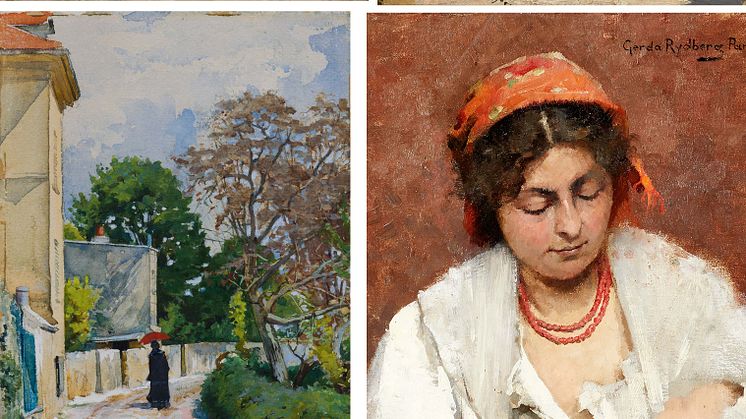
Press release -
New acquisition: Works by female artists working in France in the 1880s
Nationalmuseum has acquired four artworks by Elisabeth Keyser, Ingeborg Westfelt-Eggertz, Jenny Nyström and Gerda Tirén. They were all female Swedish artists who spent time in France in the 1880s, an intense period of change within Swedish art. Inspired by the French, they started to paint scenes from daily life, thus laying the foundation for a contemporary Swedish art that is now among the most beloved parts of our art history, with names such as Carl Larsson and Anders Zorn. With this acquisition, several important female artists can be added to that list of names.
“We are delighted to have made these acquisitions. Three of them were made thanks to a generous donation by Ann Stern. Pieces by female artists are at the top of our wish list, and we have a long-term ambition to be able to present a more complete picture of what the art scene was actually like in the late 1800s. History must never be considered as set in stone, and we are now changing the art history that was written in the 1900s by looking at what it was actually like. There female artists were many and they were known, but you would hardly have guessed it from the art history anthologies of the 1900s,” says Carl-Johan Olsson, curator at Nationalmuseum.
In Paris, young artists enjoyed a greater freedom of choice than at home. They could study at smaller, private academies, where they were allowed to start using oil paint right away, without first practicing their drawing for years. In addition, the chances of exhibiting your works were much greater. Each year, a large art exhibition was organised called the Salon. Artists could apply to exhibit their work, and if they were accepted, it meant the greatest possible exposure to the thousands of visitors who attended the event. All four of the artists whose works Nationalmuseum has now acquired were successfully accepted to the Salon.
Elisabeth Keyser travelled to Paris in 1878 and studied with such teachers as Léon Bonnat, one of the greatest portrait artists in France at the time. Keyser would also become a successful portrait artist, but in France, she mainly painted everyday motifs in the naturalist genre. Her painting A Confirmee in Normandy is a great example of how certain motifs became fashionable. In 1875, the French artist Jules Bastien-Lepage, who was a hero of many Swedish artists, had painted a confirmand, and judging by Keyser’s painting, the subject was still popular in 1889.
Ingeborg Westfelt-Eggertz lived in France at the same time as Elisabeth Keyser and they became friends. The small painting depicting the gate of a guest house in Meudon was a gift from Westfelt-Eggertz to Keyser, and we can only assume that it was in memory of a place where they had both lived. Meudon is located just outside of Paris and it attracted several Nordic artists.
The paintings of both Elisabeth Keysers and Ingeborg Westfelt-Eggertzs can be seen in the exhibition From dawn till dusk which is on display at Nationalmuseum Jamtli in Östersund.
Jenny Nyström’s watercolour painting from Paris is of a similarly informal nature. Oddly enough, there are few snapshots from the streets of Paris painted by the Swedish artists who went there. Nyström painted this watercolour in 1884, the same year that she exhibited her famous self-portrait at the annual Salon in Paris.
The fourth acquisition is a delicate study by Gerda Tirén depicting a mother holding a child in her arms. This painting is a very good example of how Swedish artists managed to capture the emotional expression while at the same time skilfully learning and applying new painting techniques abroad. The brush strokes bring to mind certain paintings by John Singer Sargent and Anders Zorn, who actually did not start painting in oil until 1887, that is, three years later.
Nationalmuseum receives no state funds with which to acquire design, applied art and artwork; its collections are enriched through donations and gifts from private foundations and funds. The acquisitions have been made possible by a generous donation from Ann Stern and contributions by Magda and Max Ettler’s donation fund.
Inventory number:
Elisabeth Keyser, A Confirmee in Normandy, 1889, NM 7478
Ingeborg Westfelt-Eggertz, Impression from Meudon, 1887, NM 7479
Jenny Nyström, A Woman Walking in Paris, 1884, NMH 1/2019
Gerda Tirén, A Mother, 1884, NM 7501
For more information
Hanna Tottmar, Press Officer, press@nationalmuseum.se, +46 (0)8-5195 4400
Categories
Nationalmuseum is Sweden’s museum of art and design. The collections comprise older paintings, sculpture, drawings and graphic art, and applied art and design up to the present day. The museum building has currently been renovated and reopened in autumn 2018. Nationalmuseum has partnerships with Svenska Dagbladet, Bank of America Merrill Lynch, The Wineagency and the Grand Hôtel Stockholm.

